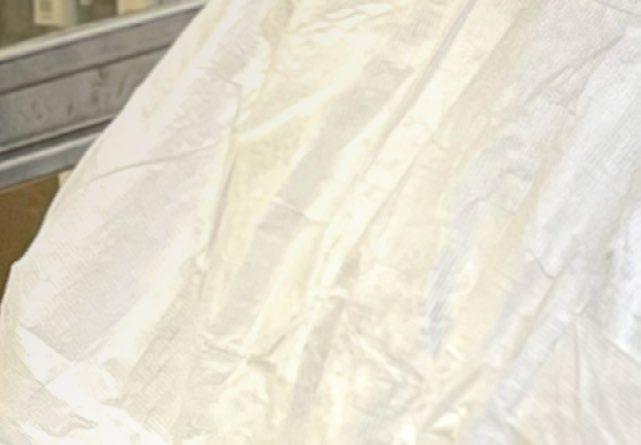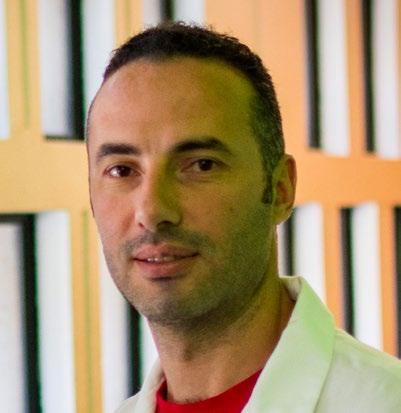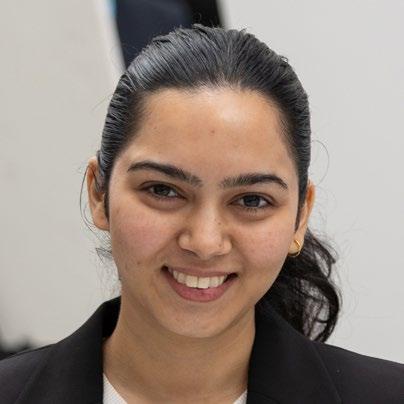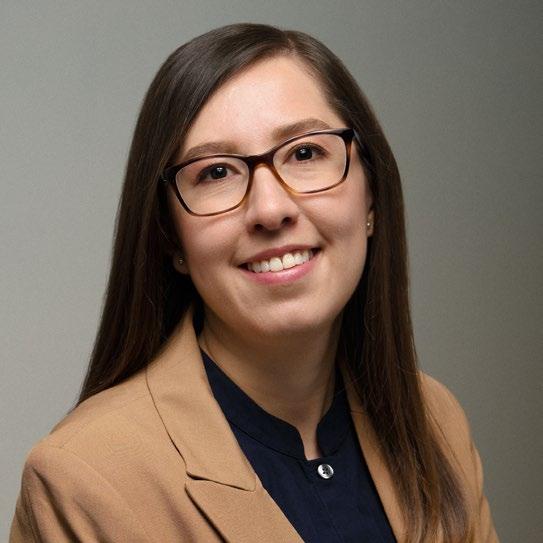






It has been an exciting transition to the chair role. I’ve enjoyed collaborating with faculty, staff, and students to pursue opportunities and tackle challenges related to UB CBE. I am grateful to all those who have helped ease the transition.
It has been another successful year for the department. The accomplishments of our early career faculty are particularly exciting. Viviana Monje received a prominent grant from the International Human Frontier Science Program, Kaihang Shi secured a grant from the American Chemical Society Petroleum Research Fund and is introducing a new course that explores the intersection of artificial intelligence and chemical engineering, Aurora del Carmen Munguía-López published a review article focused on plastic recycling that was recognized by multiple media outlets, and Hsinhan (Dave) Tsai has expeditiously launched his research program and secured a UB LAUNCH award.
CBE faculty received two high-level awards from the American Institute of Chemical Engineers (AIChE).
SUNY Distinguished Professor and Walter E. Schmid Chair Dave A. Kofke received the William H. Walker Award and Professor Haiqing Lin was the recipient of the Institute Award for Excellence in Industrial Gases Technology.
On the student front, we were thrilled to learn that junior Nicholas Reilly was awarded the prestigious Barry Goldwater Scholarship.
We are also pleased to report growth in our undergraduate program. From a national perspective, enrollments in chemical engineering programs began to decrease in 2016. Fortunately, this trend has reversed at UB. Our first-year cohort has doubled in size over the last three years. Moreover, 22 high school students joined the annual Chem-E Camp this summer. It’s all very exciting, as employers regularly remind us of high demand for our graduates!
Finally, some of you may have learned of the challenges facing higher education. CBE is not immune from these challenges. Our research programs are a strength of our department, with a history of advancing knowledge and having real-world impact. We are also fortunate to welcome talented students from across the globe. Reductions to federal research funding and restrictions on student visas place these defining characteristics of our department at risk. That being said, I am confident that the dedication and creativity of our faculty and staff will enable us to overcome these challenges.
Best regards,



Jeff Errington Professor and Chair




Over $10.65M in research expenditures
MIAO YU, Professor, is Principal Investigator on a grant of $3 million to create new industrial membranes. Funded by the United States Department of Energy (DOE), the technology could reduce greenhouse gas emissions associated with the production of food, pharmaceuticals, and chemicals.
AMIT GOYAL , SUNY Distinguished Professor, was a nominee for the 2025 Global Energy Prize, an award for outstanding achievements in scientific and technical research and development in the field of energy. He also received a $2 million award from the REMADE Institute & U.S. DOE Advanced Manufacturing Office Project, to develop Next Generation Sorting Technologies for Plastics and Textiles. Additionally, he served as on-site reviewer for finalist proposals of National Science Foundation's (NSF) largest funding—$160M, for the NSF's Type-II Engines Program.
PASCHALIS ALEXANDRIDIS leads a new $1.1 million project on “Advancing the Sorting of Textiles for Recycling,” and also a $2.2 million NSF project on plastic waste valorization and a $1.1 million DOE project on multilayer film recycling. Alexandridis is appointed Section Editor-in-Chief of Polymers , and continues leading Journal of Dispersion Science and Technology as Editor-in-Chief. Paschalis Alexandridis and Marina Tsianou co-organized the NSF workshop “Formulation Science and Engineering for the Common Good” where industry and academia experts explored emerging trends and identified future directions.
Over 50% increase in incoming undergraduates
19 PhD Graduates in 2024-2025
7 SUNY Distinguished Professors





VIVIANA MONJE , Assistant Professor, has been awarded $1.2 million from the International Human Frontier Science Program (HFSP) to study how popular aquarium fish produce crystals. (see p.6) She was also awarded a $200,000 NSF grant to develop computational notebooks to enhance student learning and design a rubric to evaluate their effectiveness.
KAIHANG SHI, Assistant Professor, received a Doctoral New Investigator grant from the American Chemical Society (ACS) Petroleum Research Fund (PRF) to research energy-efficient natural gas processing.
MARINA TSIANOU, Professor, leads the AIChE Separations Division as the elected 2025 Chair. She has served on the Division’s leadership for over 10 years as Vice-Chair, Director, Newsletter Editor, and Chair of the Crystallization and Precipitation area. Tsianou directs a Plastic Recycling REU (Research Experiences for Undergraduates) program, supported by a half-million dollars from the NSF and the SUNY Chancellor’s Summer Research Excellence Fund, enabling research for 10-15 summer interns to advance innovative solutions in plastics recycling and sustainability.
DAVID KOFKE , SUNY Distinguished Professor and Walter E. Schmid Chair in Chemical and Biological Engineering, has been recognized by the AIChE with the William H. Walker Award for Excellence in Contributions to Chemical Engineering Literature. (See p. 10)
HAIQING LIN, Professor, has won the 2025 AIChE Institute Award for Excellence in Industrial Gases Technology. The award recognizes an individual’s sustained excellence in contributing to the advancement of technology in the production, distribution, and application of industrial gases. (See p. 10)




ANDREW SCHULTZ , Associate Professor of Research, was selected for the University Advising Council (UAC) 2025 True Blue Award, for providing invaluable support to the academic advising mission of the university.
CARL LUND, UB Distinguished Teaching Professor and the UB Department of Engineering Education (DEE) founding chair, has been honored with a named speaker series—it will serve as a tribute to his contributions to the formation of engineering education at UB.
ASHLEE FORD VERSYPT Professor, has been elected to serve in AIChE's Computing and Systems Technology (CAST) Division as the 2nd Vice Chair.
AURORA DEL CARMEN MUNGUÍA-LÓPEZ , Assistant Professor, led a review article that analyzed the latest technologies in plastic recycling guided by process systems engineering approaches. The Outpost, Phys.org, Environmental News Network, Scrap Monster, and Niagara Frontier Publications reported on the review, which was selected as the cover for the July issue of Industrial &Engineering Chemistry Research She also co-authored a review on solvent-based plastic recycling technologies, published in Nature Chemical Engineering
Viviana Monje and colleagues awarded $1.2 million grant to study how popular aquarium fish produces crystals
Viviana Monje, Assistant Professor in the Department of Chemical and Biological Engineering at the University at Buffalo, has received a $1.2 million grant from the International Human Frontier Science Program (HFSP) to examine how zebrafish produce a crystal to adjust their skin pigmentation.
Zebrafish are a popular aquarium fish whose genetic and physiological makeup are similar to humans’, and as such could unlock new treatments for kidney stones and gout. The fish have long been used to study possible treatments for cancer, cardiovascular disease, infectious diseases, and more.
“Our goal is to uncover how the crystallization process in zebrafish occurs,” says Monje.
The team will focus on an essential but unexplored structure: the lipid membrane that encloses each crystal inside a cell.
Her collaborators include Noemi Jimenez-Rojo, PhD, group leader and Ikerbasque research fellow at the University of the Basque Country, Spain, and Rita Mateus, PhD, research group leader at the Max Planck Institute of Molecular Cell Biology and Genetics in Germany.
Based in France, HFSP is an international organization that promotes collaboration
for research focused on the complex mechanisms of living organisms. The three-year, $1.2 million award for their project, “MetaCrystal: Metabolic principles of intracellular crystallization,” comes from HFSP’s prestigious Early Career Grant program. Each investigator will receive $400,000.
“We will leverage resources at the Center for Computational Research, UB’s leading high performance computing cluster facility, to study the specific interactions and role of lipid molecules on crystal formation at atomistic levels. Specifically, how their chemical nature and ratio affect the crystal lattice, size, and shape,” Monje says.
“Our goal is to uncover how the crystallization process in zebrafish occurs.”
– Viviana Monje

The researchers hope to fully understand the iridosome — an organelle that produces crystals inside specialized pigment cells in zebrafish — determine its makeup, and how these different mechanisms interact, and eventually replicate the crystallization process in the lab.
While the project focuses on zebrafish, the findings could suggest similar processes in other organisms the team may explore next.


The Department of Chemical and Biological Engineering at the University at Buffalo continues to strengthen its research leadership in clean energy with the addition of HSINHAN (DAVE) TSAI, who joined as an Assistant Professor in spring 2025.
Dr. Tsai completed his postdoctoral training with Professor Jeffrey R. Long in the Department of Chemistry at the University of California, Berkeley, where he developed metal-organic frameworks (MOFs) for direct air capture (DAC) and integrated solar energy into carbon capture systems. The team pioneered a passive, modular DAC device capable of operating in diverse environments without dependence on local energy infrastructure. These scalable systems are designed to capture tons of carbon dioxide annually, either for permanent sequestration or conversion into value-added products.
At UB, he has already secured early support through the UB L AUNCH Fund and an industrial exploratory partnership. His research group is developing hybrid semiconductor materials for applications in radiation detection, gas barriers, and photocatalysis, with the overarching goal of enhancing device performance and longevity in extreme environments.
By combining the complementary properties of hard and soft materials, the team is designing next-generation radiation detectors and photocatalysts for carbon conversion, and employing high-throughput automation platforms to accelerate materials discovery.

Dr. Tsai’s interdisciplinary work supports UB CBE’s strategic vision to lead in sustainable energy and advanced materials research.

Every aspiring engineer is familiar with the requisite math, physics, and chemistry courses that lay the foundation for a career in the profession. Now, among the traditional roster of courses at UB, engineering students can also delve into the technology of craft beverages.
First offered in 2018, “Beer, Wine, Spirits—Technology & Business of Craft Beverages,” CE 411 was developed as an elective course that taps into the increasing popularity of the global craft beverage movement.
“Our faculty were discussing options of enticing undergraduate majors other than our own to enroll in chemical and biological engineering courses. Half-jokingly, I suggested we offer a class on beer brewing,” says Blaine Pfeifer, a professor in the department.
Since its launch, the course has become a popular elective, consistently filling seats and even convincing some participants to pursue internships and full-time careers in the craft beverage industry. And there’s more to it than wine and beer.
Engineering consultant and adjunct faculty member Bob Kosobucki, who helped develop the curriculum, says that “after researching what was being done at other universities,
I discovered that craft beverage courses are typically focused on one type of beverage, such as beer, wine or cider, for an entire semester. What I decided to do differently with CE 411 was to cover other craft beverages—like kombucha, mead, sake, vinegar, and distilled spirits—in addition to beer and wine.”
Kosobucki dedicates the first lesson to covering the effects of alcohol on the body and the responsible consumption of alcohol. Participants then learn how chemistry, food microbiology, and engineering are all key elements of craft beverage processes. Students are also introduced to the financial and customer service aspects of running a successful craft beverage business.
For one assignment, students are tasked with designing a beer recipe and presenting their creations to their classmates. The experience allows students to observe how small changes in a recipe can affect a beer’s characteristics of taste, aroma, mouthfeel, and appearance.
“It was one of the first courses that encouraged me to conduct my own research on a topic and confidently present what I had learned,” says Armband. She landed a summer internship at E. & J. Gallo Winery in Modesto, California. She planned to return to pursue her master’s degree
in chemical engineering, but a full-time job opportunity arose and, today, she works as a research associate at Gallo Winery, the largest family-owned winery in the United States and the largest exporter of California wines.
The class has added assistant professor of teaching Maura Sepesy, who has her fair share of experience in brewing beer, mead, and wine; she even participated in the American Institute of Chemical Engineers’ Beer Brewing Competition in 2021 as a graduate student at Case Western Reserve University. According to Sepesy, craft brewing is a task well suited to chemical engineers because it involves chemical reactions, fluid mechanics, and an understanding of how to scale up a process. She’s excited to teach a class that is so hands-on and unique. While the first few classes were predominantly attended by engineering students, the department welcomes all students who meet the prerequisites.
“It was one of the first courses that encouraged me to conduct my own research on a topic and confidently present what I had learned. ”
— Jenna Armband
Excerpted from “Engineering a New Brew” by Sarah D'Iorio, first published October 17, 2024


Professor HAIQING LIN has won the 2025 AIChE Institute Award for Excellence in Industrial Gases Technology. According to the AIChE, the award “recognizes an individual’s sustained excellence in contributing to the advancement of technology in the production, distribution, and application of industrial gases.”

Haiqing joined UB CBE as an assistant professor in 2013 and was promoted to professor in 2021. His research focuses on polymer-based membranes for carbon capture. Specifically, his group developed nanofilm composite membranes based on novel polyethers and metal-organic frameworks for CO2 capture from flue gas, and polymer-derived inorganic membranes for H2 purification from syngas, such as carbon molecular sieves, organosilica, and amorphous zeolites.
Over the course of his career, Lin has published nearly 160 papers and 7 book chapters, and secured 10 patents and applications. He has graduated 50 graduate students and welcomed 50 undergraduate students into his research group.

from calculation
SUNY Distinguished Professor DAVID A. KOFKE , the Walter E. Schmid Chair in Chemical and Biological Engineering, has been recognized by AIChE with the William H. Walker Award for Excellence in Contributions to Chemical Engineering Literature.
Kofke is known for his foundational work in molecular modeling, a computational approach that predicts material properties from a molecular perspective. Though more complex than empirical methods, molecular modeling offers superior predictive power and insight. His contributions have significantly improved the accuracy, speed, and reliability of these methods, enabling broader adoption across the research community.

His innovations have helped the field’s movement from using simplistic molecular models toward more sophisticated, application-oriented approaches. These advances, increasingly supported by developments in quantum chemistry and machine learning, are transforming the chemical and materials industries. Kofke’s contributions have empowered countless researchers and elevated the role of molecular modeling in chemical engineering.

JADA MOWATT (Haiqing Lin group) has been selected as a 2024-2025 NASA/New York Space Grant Consortium: National Space Grant College and Fellowship Program fellow. The distinction recognizes Mowatt and her research for close alignment with NASA’s technological goals and areas of interest. She was also selected by the Oak Ridge National Laboratory (ORNL) to receive a GEM Fellowship and complete an internship there as part of their Fuel Cycle Chemical Technology Group on enhancing the nuclear fuel cycle using membrane and separation processes.
Mowatt is from Brooklyn, NY, and anticipates conferring in 2027. She completed her B.S. degree in Chemical Engineering from UB in May 2022. At Brooklyn Technical High School, she enrolled in college-level classes and chose to attend UB’s School of Engineering and Applied Sciences (SEAS) because she was intrigued by the excellent research opportunities available for undergraduate chemical engineering majors. She participated in undergraduate research with the Louis Stokes Alliance for Minority Participation (LSAMP) Program during her first year, and investigated the crystallization of calcium oxalate via polymers in relation to kidney stone formation.
Mowatt has been involved on UB’s campus outreach programs, and has worked in the Orientation, Transition, and Parent Programs office as a Welcome Weekend Leader, Orientation Leader, Orientation Team Leader, and Orientation Student Assistant from 2019 onward. She also has worked in Campus Living as a Community Assistant, Academic Assistant, Resident Advisor, and Conference Host since 2020. She’s served as a First Impressions Student Assistant for UB SEAS Dean Kemper Lewis and was selected as the Groundbreaking Student Speaker for the upcoming SEAS Agrusa Hall by President Satish K. Tripathi. Currently, she is the Graduate Student Representative of SEAS Justice, Equity, Diversity, and Inclusion (JEDI) Executive Committee, and the President of UB’s STEMinism, an organization for women of color in STEM. She’s also served as a Lecturer for EAS 498: Research Methods for the LSAMP summer research program.
After graduation, Mowatt would like to work in industry, a government agency, or at a national laboratory, focusing on research and development to help the environment and society. Ultimately, she’d like to complete a postdoctoral program and become a university faculty member.





VINH BUI, BS 2020 and PhD 2025 (Haiqing Lin group) has won the AIChE Separations Division - Graduate Student Research Award. His dissertation focused on the development of organosilica membranes with superior H2/CO2 separation properties for hydrogen purification and carbon capture. He developed holistic approaches in synthesizing nanomembranes with nanotechnologies such as plasma treatment and atomic layer deposition, resulting in five first-authored peer-reviewed articles and more than 10 co-authored papers. He also won other research prizes, including the Student Fellowship Award from the North American Membrane Society (NAMS).
(Stelios Andreadis group) received the prestigious NIH Pathway to Independence Award (K99/R00). The NIH K99/R00 Award provides up to 5 years of grant support for promising postdoctoral scientists seeking to complete mentored research career development that will facilitate their timely transition to an independent, tenure-track or equivalent faculty position.
OMKAR DESAI (David Kofke and Andrew Schultz group) was a finalist in UB's three-minute thesis competition. His research focuses on enhancing gas separation capacity and decreasing gas separation costs by using molecular simulation to simulate metal–organic polyhedra’s (MOP's) gas absorption and separation capacity. He and his research team have also developed a new theoretical model to estimate these results and computed a methodology to simulate MOP, which has realistic results similar to those of experiments. He hopes his research will help reduce energy demand and increase productivity.
YULUN WU and MOHAMED ALAA ELDEIN MOHAMED (Stelios Andreadis group) recently published a paper in Biomaterials “Self-healing and cell-free vascular grafts.” The study presents the development of autonomous self-healing elastomers for engineering bi-layered vascular grafts, which demonstrate rapid self-healing within seconds post-injury, and support endothelialization. Such self-healing, cellfree grafts hold significant promise for applications in arteriovenous access and other vascular interventions, particularly for hemodialysis patients. In addition, Yulun Wu was awarded the Ajinkya Fellowship, which recognizes outstanding graduate students at UB.
ALI GHASEMI (Marina Tsianou and Paschalis Alexandridis groups), was awarded a NSF-sponsored travel grant to participate in the 2025 REMADE (Reducing Embodied Energy and Decreasing Emissions) Circular Economy Tech Summit & Conference, April 10-11, 2025, in Washington, DC. He is a co-author in the conference paper “Molecular Recycling of Plastics Facilitated by Solvents” by Alexandridis, P.; Atkinson, J. D.; Ferger, C.; Ghasemi, A.; Licht, J.; Mousania, Z.; Solanki, S.; Tsianou, M.
ARIEL M. LIGHTY Ashlee Ford Versypt group) received a SUNY Graduate Research Empowering and Accelerating Talent (GREAT) award, which incentivizes NSF Graduate Research Fellows to pursue PhDs at SUNY institutions. Estrogen loss is an inflammatory process that occurs as women age. Prebiotic dietary fibers are a promising treatment for bone loss, and Lighty’s research addresses gaps in the understanding of how the prebiotics interact with estrogen loss. She is using computational models to simulate these interactions' effects on gut inflammation, an effort that Lighty said would be hard to achieve by experimental research alone. Insights from Lighty’s models will help to guide ongoing experimental efforts and improve understanding of the complex processes surrounding inflammation and aging. Recipients of the SUNY GREAT awards receive $7,500 in funding from the SUNY Office of Research and Economic Development to use for research expenses, related travel, professional development, and stipend augmentation.

SHIKHA SOLANKI (Paschalis Alexandridis and Marina Tsianou groups) was selected for the Best Poster award at the Society of Plastics Engineers (SPE) FlexPackCon 2025 conference held in Rochester, NY in May 2025. Shikha presented the paper “Dissolution/Precipitation Recycling of Polyolefins with Closed-Loop Cycling of Switchable Solvents.”

LAURA SHERWOOD (Stelios Andreadis group) recently presented her research at the Salivary Glands and Exocrine Biology GRC (Gordon Research conferences) meeting through an oral presentation and poster, which received second place. She was also awarded a NIH three-year F31 fellowship entitled: Human Pluripotent Stem Cells and Organoids for Salivary Gland Regeneration. Sherwood is using a developmentally inspired approach to engineer functional salivary gland organoids from human induced pluripotent stem cells. These organoids have potential applications in treating salivary gland dysfunction, promoting regeneration after radiation therapy, and serving as platforms for drug screening and testing.

ZHENGXI XUAN (Mark Swihart group) is a recent PhD graduate who developed colloidal chemistry routes to control the shape and properties of zinc oxide (ZnO) nanostructures. ZnO has broad applications from cosmetics to electronics, but Dr. Xuan’s work focused on imparting magneto-optical properties by doping it with magnetic elements. His most recent paper, in Chemical Science, presented irondoped ZnO nanostructures with “hand-shaped” or “truncated pyramid” morphologies. Forthcoming work shows how doping with multiple elements produces unprecedented magneto-optical responses. Zhengxi (BS 2019, MS 2021, PhD 2025) is now a triple alumnus of our department!




GRADUATE STUDENT ACCOMPLISHMENTS & RESEARCH ( cont. )

(Amit Goyal group) is an MS student who has developed a wet chemical process for forming microbridges in superconducting EuBa2Cu3OxBaHfO3 thin-films. In this research, a wet chemical etching process was developed for fabrication of microbridges on superconducting EuBa2Cu3OxBaHfO3 thin-films via monitoring step heights by AFM and confirming no-degradation in superconducting properties by resistance-temperature and AC transport measurements.
“Superconducting properties of nanostructured EuBa2Cu3O7x+3.4vol%BHO films via transport measurements on chemically etched microbridges,” R. Kumar, M. Peddireddy and A. Goyal, has been submitted for publication in the proceedings of the 2025 Nanotechnology Materials and Devices Conference (NMDC) (NMDC 2025), October 12-15, 2025.

Chemically etched EBCO+3.4%BHO thin film with 50µm bridge

“First and foremost, the environment is precious to me.”
— Nicholas Reilly
The Barry Goldwater research scholarship is one of the most prestigious and competitive that are offered to undergraduate students in STEM. NICHOLAS REILLY plans to use the support to focus his research on material science, specifically on materials to mitigate carbon emissions and combat greenhouse effects.
In his application, he wrote, “First and foremost, the environment is precious to me. It has been a lifelong dream to dedicate my career to preserving it for future generations, as I wish others had for us. Secondly, my experience in research projects at UB has fueled my passion for scientific problem-solving. Pursuing a PhD will develop my experience and research ability to work on climate-focused prospects, making it a clear choice for me.” Reilly was among 441 students from across the United States to be selected to receive scholarships for the 2025-26 academic year by the Goldwater board.

CASSIDY SHAFER joined the Sustainable Systems Engineering Lab, led by Aurora del Carmen Munguía-López, in February 2025. During the spring semester, she worked on the project “Environmental and Economic Analysis of Food Waste Valorization Technologies.” Although food waste is an organic material that can be valorized, approximately 60% of food waste generated in the U.S. is still sent to landfills and approximately 15% is burned in controlled combustion facilities. Shafer performed a preliminary life cycle assessment comparing different alternatives to valorize food waste. She presented her research at the STEM for Everyone event hosted by UB and won second place for her presentation.
Two Junior Faculty have won UB Research and Creative Activities for Undergraduate Students Program awards (URCA). URCA is a SUNY-funded program in partnership with the Experiential Learning Network (ELN), Career Design Center, and Office of Research and Economic Development with the goal of broadening access to research and creative activities for undergraduates at UB. Through this program, undergraduates will participate in faculty mentored research and creative activities across various disciplines and have opportunities to interact with other undergraduate and graduate students engaged in research at UB.

KAIHANG SHI, Assistant Professor, received two such awards; one in spring 2024 for “Computational Discovery of Materials for CO2 Capture” and another in December for “Exploring Materials Synthesis Conditions via Large Language Models”. So far he has mentored four students through the programs—Jeffrey Zhang, Jeffrey Cai, Will Cousins, and Julia Singh, whose backgrounds include mechanical engineering, computational physics, and computer science, in addition to chemical engineering. The award funds expenses ranging from lab supplies, housing, and meal allowances to professional development opportunities to expand research or present at conferences or meetings, and travel.


, Assistant Professor, received an URCA grant for the project “Assessing the Economic and Environmental Benefits of Technology and Policy Pathways for Plastic Recycling in the U.S.,” and mentored two students through the program. One of the students, Matthew Bablin, created a database featuring the greenhouse gas emissions of several recycling technologies from a product perspective, and then developed a computational framework to quantify uncertainty in the reduction of emissions by each pathway. He presented his preliminary results at the UB Celebration of Excellence and will also present his work at the 2025 AIChE Annual Student Conference in November.
SAGNIK DAS (Haiqing Lin group) was a finalist in the University at Buffalo's recent Art of Research competition, which celebrates research by showcasing original images that capture the visual beauty of research, scholarship, and creative pursuits. Das’ research focuses on the development of advanced membrane technologies for selective lithium (Li+) extraction from seawater, and he chose this surrealistic representation to capture attention and evoke the idea that energy solutions of the future may lie hidden in plain sight, within our oceans.




On Friday, April 25, 2025, UB CBE hosted Joan Brennecke, Cockrell Family Chair in Engineering in the McKetta Department of Chemical Engineering at The University of Texas at Austin, who presented the annual Eli Ruckenstein Memorial Lecture, and spoke on “Supported Ionic Liquid Membranes for Direct Air Capture of CO2.” The Ruckenstein Lecture, held each spring, honors the late Eli Ruckenstein, a prolific researcher who made contributions in almost every subfield of chemical engineering. Each year, the series brings a distinguished scholar in chemical or biological engineering to our campus to speak about research activities in their laboratory, trends in the field, and larger problems in society that chemical engineers can address.
Over 200 people participated in the UUBB CCBBEE GGrraadduuaattee RReesseeaarrcchh SSyymmppoossiiuumm held on Friday, October 4, 2024. The event featured over 60 posters, two lectures from senior graduate students, and a keynote lecture from Dan Ammon, PhD 1999, of Regenity Biosciences. PhD candidates Bratin Sengupta (Miao Yu group) and Ronel Zachary Samuel (Stelios Andreadis group) provided opening lectures. The poster contest and reception were held in the Center for the Arts Atrium. The Friday, October 17, 2025 Symposium features David M. Ford, Dean, Bagley
College of Engineering at Mississippi State University.




linkedin.com/groups/4334724/
